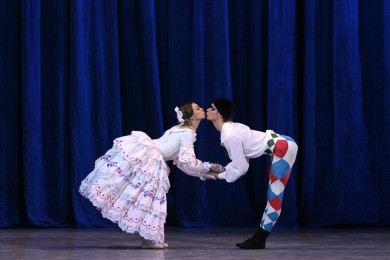Music by Robert Schumann
Choreography by Michel Fokine
DIVERTISSEMENT
Scenes and pas de deux from the ballet and choreographic compositions
CARNAVAL
pantomime ballet in one act
Music by Robert Schumann (Le Carnaval, Op. 9, orchestrated by N. Rimsky-Korsakov, A. Lyadov, A. Glazunov, N. Cherepnin, A. Arensky)
Choreography by Michel Fokine (1910)
Set and Costume design by Leon Bakst
The revival team:
Choreography staged: Sergei Vikharev
Sets reproduced: Mikhail Shishliannikov
Lighting: Alexander Naumov and Mikhail Shishliannikov
Costumes reproduced: Tatiana Noginova
Staged in 1910 for a charitable evening, choreographer Michel Fokine and designer Léon Bakst’s Le Carnaval entered the annals of ballet history as a delightful stylisation of commedia dell'arte to music by Schumann. Fokine was inspired to create the production through his familiarity with the real-life peripeteia of the composer, finding a response in pieces from the piano cycle Le Carnaval. The duplicity of Schumann's spirit was reflected in the images of the fervent Florestan and the sentimental Eusebius, the beautiful Estrella brought to mind the composer's fascination with Ernestine von Fricken, and the coquettish Chiarina embodied his love for his future wife Clara Wieck. In Schumann's pieces there was also room for Fokine's beloved ideas of the struggle with philistines, adherents of the old traditions of art. "From all this, from the titles indicated in the sheet music – ‘Harlequin', 'Columbine', 'Pantalone', 'Pierrot' and 'Butterfly’ – I immediately saw a ballet scene,” the choreographer recalled, "It is a series of individual characteristics, mutually linked by the constant appearance of the deadbeat Pierrot, the humorous Pantalone and the always victorious-over-all Harlequin with his pranks and escapades. The brief plot surrounding the love between Harlequin and Columbine, the failures of Pierrot and Pantalone – all of this was literally improvised during rehearsals. The ballet was staged after three rehearsals..." One witness of the first performances of the ballet thus described the harmony of the characters: "A jest, a prank, in combination with the athletic power of Harlequin are reconciled in the tenderness" of his partner Columbine. In the series of enchanting scenes the charm depended on small, imperceptible and fleeting gestures, crafty smiles, coquettish flights and the "steely affectedness that conveys the age." The performers of this ballet did not have to dazzle with their technique in the complex dance passages, the main task of the dancers was to create an atmosphere of unforced play and levity. Famous dancers appeared in Le Carnaval in their day – Tamara Karsavina, Lydia Lopukhova, Leonid Leontiev and Vaslav Nijinsky. The role of Pierrot at the premiere was performed by the emergent stage director Vsevolod Meyerhold. Following the success of the ballet at its premiere, Sergei Diaghilev included it in his Saisons russes programme, in 1911 Le Carnaval was staged at the Mariinsky Theatre, and subsequently Fokine took it to theatres in Stockholm, Copenhagen, Buenos Aires, New York and numerous private theatre enterprises. In Russia, following many years of oblivion, in 1962 Konstantin Sergeyev restored Fokine's stylisation to the repertoire. And in 2008 the production took on a new life and today it delights audiences in reconstructed form after sketches by Fokine in a version by Sergei Vikharev.
Olga Makarova
 Mariinsky Theatre:
Mariinsky Theatre:  Mariinsky-2 (New Theatre):
Mariinsky-2 (New Theatre):  Mariinsky Concert Hall:
Mariinsky Concert Hall: 

